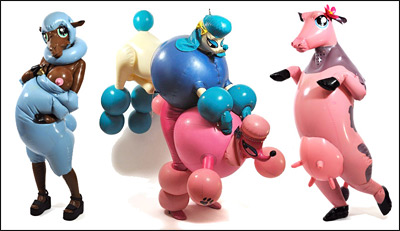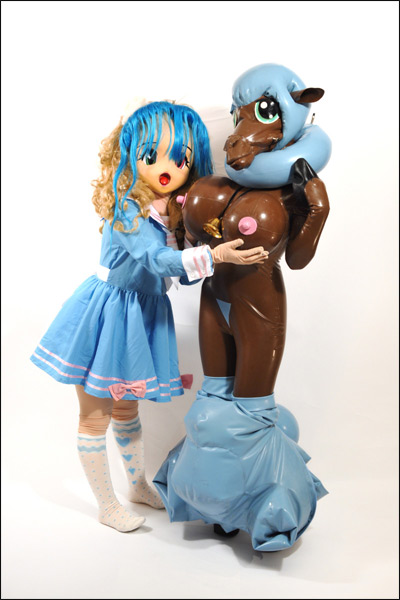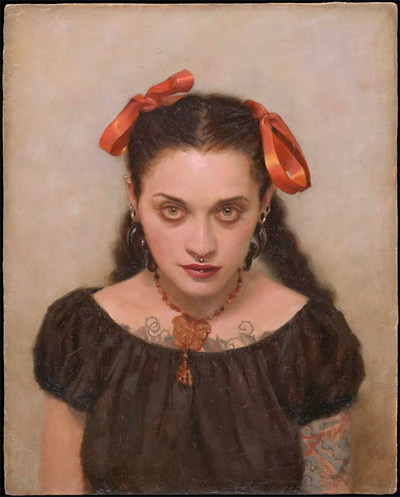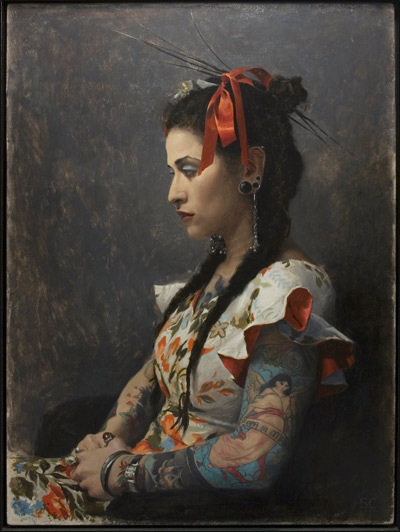BTC: Do the Batusi!
Batman dances the Batusi after being tortured to insanity by King Tut (arguably the most edgy and terrifying Batverse villain iteration after Ledger’s Joker). Hilarity ensues.
Thanks, Gooby!
Batman dances the Batusi after being tortured to insanity by King Tut (arguably the most edgy and terrifying Batverse villain iteration after Ledger’s Joker). Hilarity ensues.
Thanks, Gooby!

Ho hum. Just another quiet Sunday afternoon on the internubz…
Via Aaron English, with cackling thanks.
Also see:

Sure, most of us can wholeheartedly agree that FOX NEWS SUCKS. But credit must be given where it’s due: they handled their recent interview with a vampire scrappy, sharp-toothed home owner respectfully and professionally:
Via Eric Cheng, thanks!
While there’s no doubt that FOX aired this segment knowing full well it would go viral and bump their ratings, the story of homeowner Patrick Rogers turning the tables on a life-draining bank like Wells Fargo would be a joy to hear even if he wasn’t a darque and sultry creature of eternal night.
After the bank tried to bully Rogers into paying an outrageous insurance premium, the black-clad, fanged resident of Philadelphia, PA, found a little-known, 30 year-old law, and successfully foreclosed on them. Ha!

I’m not sure how Hulu works in countries outside the US at this point. My apologies if you cannot watch this, it’s one of the reasons I try to avoid sites like Hulu.
It’s Friday, people, which means that there’s only a few more hours until you can stick a fork in another soul-crushing work week. Allow the FAM to help that time pass a little more quickly with this week’s presentation of Don Bluth’s 1982 classic The Secret of NIMH, starring, among others, Mary Elizabeth Hartman (in her last role before her suspected suicide), John Carradine, Dom DeLuise, Aldo Ray, and Wil Wheaton.
An adaptation of Robert C. O’Brien’s 1971 children’s novel Mrs. Frisby and the Rats of NIMH, the movie tells the story of Mrs. Brisby, a widowed field mouse, whose son falls ill with pneumonia and cannot leave the house for three weeks. At this time, Spring plowing is set to begin on the farm the Brisbys live on and Mrs. Brisby, knowing she cannot stay where she is, visits the Great Owl who directs her to a group of mysterious rats who live in a rose bush and are led by a wizened old rat named Nicodemus. Brisby learns that the rats, along with her late husband Jonathan, were part of an experiment performed at the National Institute of Mental Health which boosted their intelligence to human levels at which point they made their escape.
The Secret of NIMH was a favorite of mine as a child and recent viewings have done little to dampen my enthusiasm for it. Bluth and his partners, most of who had defected from Disney with him, were fixated on what they perceived to be the decline of animation as an art form. The Secret of NIMH, then, was a collection of expensive and, even at the time, outdated animation techniques. The glowing eyes of Nicodemus, for example, were created by back-lighting colored gels. Characters had different color palettes for individual lighting situations (Mrs. Brisby alone had 46). It’s a veritable showcase of animation and it all makes for a beautiful film. Still, it came at a price, and the film came in so over the original budget that Bluth and his co-producers had to collectively mortgage their homes to finance some of it. There was even a problem with their diminutive protagonist’s name:
During the film’s production, Aurora contacted Wham-O, the manufacturers of Frisbee flying discs, with concerns about possible trademark infringements if the “Mrs. Frisby” name in O’Brien’s original book was used in the movie. Wham-O rejected Aurora’s request for waiver to use the same-sounding name to their “Frisbee”, in the movie. Aurora informed Bluth & company that Mrs. Frisby’s name would have to be altered. By then, the voice work had already been recorded for the film, so the name change to “Mrs. Brisby” necessitated a combination of re-recording some lines and, because John Carradine was unavailable for further recordings, careful sound editing had to be performed, taking the “B” sound of another word from Carradine’s recorded lines, and replace the “F” sound with the “B” sound, altering the name from “Frisby” to “Brisby”.
In the end, there are really two things that make NIMH stick out: its tone and its protagonist. The mood of the film is exceedingly foreboding, especially for a G-rated feature intended for children, without crossing into the historical seriousness of, say, Grave of the Fireflies or the political allegory of Watership Down. When I think of it, the images that come to my mind are bleak, eerie, and filled with fire. Likewise, its heroine is unlike anything one would have seen from Disney. Mrs. Brisby is no princess. She is a middle-aged mother and widow. Her quest is not an epic struggle between good and evil, it is to save her family. She doesn’t fall in love with a dashing male lead, she is not even looking for it, the love she had for another is in her past, before we are even introduced to her. Is she one of the great feminist characters in film? No. But she is a refreshing change from the typical Barbie doll pap most peddle.
Watching The Secret of NIMH it is perhaps most evident that it is a labor of love, both for its story and for the medium it is presented in. It is not a stretch to say that they don’t make them like this anymore. After all, who would be crazy enough to try?

Black Coffee: Chapter 1 of Trails of Tarnation from New Picture Agencies on Vimeo.
From Nicholas Gurewitch, cialis sale creator of The Perry Bible Fellowship comes Trails of Tarnation, recounting the travels and travails of Jeff and Derek. In this inaugural episode, entitled “Black Coffee”, Derek instructs Jeff on the proper way to brew that most holy of morning beverages with unintended consequences.


From Japan with love: Sexy Sheep, Fucking Poodles, Pink Cow. Don’t let Katy Perry ruin latex. Take it back. [via 3XL]
See also:



Portrait of Chantal Menard
Some lovely portraits by Sean Cheetham, view whose blog can be found here. Cheetham grew up in the Bay Area, pilule and studied painting in Pasadena under Michael Hussar. Similarly to New York painter Steven Assael, see who created iconic portraits of people from the heydey of the nightclub Mother, Cheetham has a gift for presenting alternative-looking people in a very formal, classical way.

Chantal Profile


If you like folksy, bluegrassy, skifflepunky, lyrically deft and tenderhearted wonderfulness, you need to give Marcellus Hall’s new solo record, The First Line, a listen. It’s out this week. This is Marce:

I first met the accomplished musician/writer/illustrator at the Mercury Lounge in NYC in 1998 after my shambolic, sloppy-drunk gig opening for The Gunga Din. Honestly? NOT the best night… until Marce found the dark corner I was hiding in, said “Hey, I like your style,” and asked me to play violin with his band. Something about the guy made me say yes without blinking. Maybe it was because he reminded me of Conan O’Brien’s younger, more soft-spoken brother: tall, thin, fair, somewhat ageless, he had that same quick and kindly wit. After saying yes, I realized I should probably ask him what sort of music he made.
“Well, I used to be in this band called Railroad Jerk.” Oh, yeah! I had some notion of Railroad Jerk. Weren’t they one of the first bands to sign to Matador? They were on that What’s Up, Matador? compilation with John Spencer Blues Explosion, Helium, Guided by Voices, Liz Phair, Yo La Tengo, etc…
“Yeah. That’s done,” he said. “Now I have a band called White Hassle.” White Hassle? “Yeah, um. It’s a pun. You know, White Castle.” Well, hey. Why not. I remember much of my decade in NYC as a sad, scrambling time, but all of those shows and records I did with Marce’s “junk folk pop ’80s rock electro-blues” outfit (in cahoots with drummer Dave Varenka and an assortment of other wonderful players) are among my fondest memories.
In more recent years, Marce has been crafting a new sound. It’s a bit softer, more contemplative than the huge, herky-jerky energy of his previous work, but those razor-edged lyrics, rich guitar chords, feverish harmonica solos and spot-on vocals are bright and sharp as ever.

Marce has always been a thoughtful guy, and while his songcraft might seem like straight-up, uncomplicated acoustic country fare on the surface, listen more closely and you’ll realize there’s a lot more going on with his lyrics and presentation than the usual, weary old “my dog died and the old lady left me” American folk tradition scalp-taking. Marce’s wry, self-aware humor is evident in references to emailing, texting, even the act of songwriting itself in the title track. From a recent review over at The Observer:
Hank Williams, Woody Guthrie, Dylan, and the Everly Brothers are obvious reference points—Americana fans will love this album—but Hall doesn’t really go in for nostalgia, and careful listeners will also hear echoes of the Modern Lovers, Einstürzende Neubauten, and New York’s No Wave bands. Like them, Hall lets the sounds of his city seep into the recordings; the tracks sound simultaneously organic and artificially distressed.
In addition to making great music and poetic lyrics, Marce does wonderful illustration work for The New Yorker, the Village Voice and others. You can learn more about that and other facets of his career at his personal website. Obviously, by now, you’re aware that I can’t say enough good things about this fella. If your curiosity is piqued and if you’re not already familiar with his work, I almost envy you: you’ve got 20+ years of fantastic Marcellus Hall music to get acquainted with. I heartily recommend starting with The First Line, and going from there.

It wasn’t even the deliveryman’s use of profanity that bothered Joanne. No, she had endured plenty of course language in her time (and used a fair bit herself for that matter). What really irked her was his indifference to her protests over the state of the package he asked her to sign for. Indifference was, perhaps, a misnomer. So smug was his bearing that Joanne had no doubts that the man had interpreted the “Fragile” stickers that festooned the box as “Kick Me” signs. She was sure he had done this on purpose and when he spat “Go ahead, call the goddamn office if it makes you feel better,” in response to her indignant threat it only made that conviction stronger. This miserable little man, unshaven and reeking of cigarettes, obviously got his kicks by torturing customers. No doubt he was a member of some awful labor union, and felt safe in the knowledge that this offense was just another in a long line of similar incidents that would go unpunished. This time would be different, however. His employer may have been rendered impotent by socialists but Joanne had no such impediment. This man was about to learn that no one fucks with the Pink Armadillo and walks away unscathed.
It would be a lesson he would not soon forget.

Al Jazeera English has proven to be, perhaps, the best news organization going at the moment with their top-notch coverage of the events transpiring in the Middle East. In this particular segment of their program 101 East, they turn their eye to another oppressed nation: North Korea, specifically the Pyongyang University of Cinematic and Dramatic Arts. Here, as everywhere else, the curriculum is focused on the teachings of the state, specifically Kim Jong Il, heralded in his country as a cinematic genius. The university, then, is a training ground for the actors and directors who will make up the North Korean government’s propaganda machine.
To their credit, reporters Lynn Lee and James Leong have few illusions as to what their report is about. While they do manage to get inside the school, much of their footage is confiscated due to the draconian rules for filming within the university (only uncropped, stationary shots of images of the Dear Leader and his words). It is, however, an interesting look at how the elite live in the nation’s capital city. The country is once again experiencing food shortages, but while most of the country starves, its embassies instructed to beg for food, high ranking members of the North Korean government live in relative luxury. Of course, as we have seen before, not everything is quite as it seems in the DPRK.
